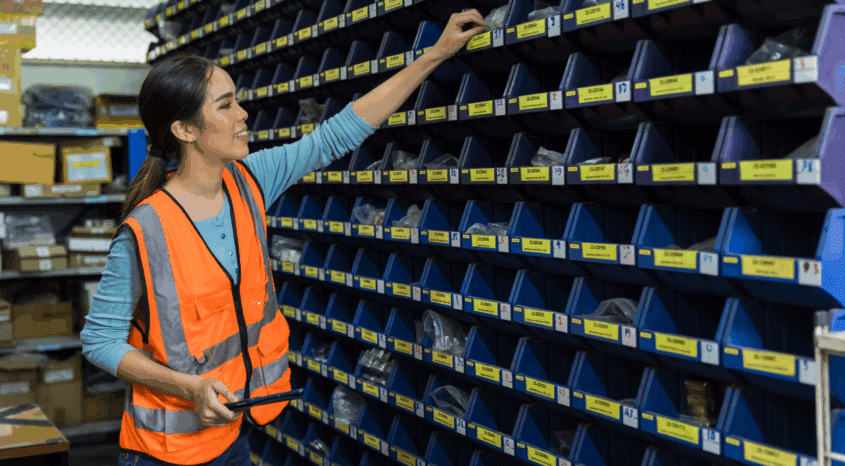Smooth business operations often hinge on a well-functioning warehouse. A disorganized or inefficient warehouse can lead to delays and errors that affect your bottom line.
In this blog, we’ll guide you through the essential steps to build and manage a strong warehouse team, driving efficiency and ultimately contributing to your business’s success.
The Importance of a Strong Warehouse Team
A strong warehouse team is essential to keeping your supply chain running smoothly. Their day-to-day responsibilities, like maintaining inventory accuracy and ensuring timely shipments, directly impact efficiency and customer satisfaction.
When the warehouse team performs well, operations run more smoothly. Goods move consistently, errors are reduced, and costly disruptions are minimized.
This performance has a ripple effect across your business. An efficient warehouse team helps lower operational costs, improve lead times, and increase product availability. As a result, customers receive their orders faster and more accurately. Satisfied customers are more likely to return, recommend your business to others, and stay loyal, driving long-term growth and profitability.
Best Practices for Building and Managing a Strong Warehouse Team
Building and managing an effective warehouse team requires intentional hiring, strong leadership, and a collaborative work environment. Here are some best practices to help guide the process:
1. Recruiting the Right People
Building a strong warehouse team starts with finding the right people. Key qualities to look for in warehouse personnel include reliability, the ability to handle the physical demands of the job, attention to detail, strong organizational skills, and problem-solving abilities.
To attract team members who meet all the criteria, create clear job titles and descriptions that outline the necessary skills, expectations, and key responsibilities of the role. Include detailed information about day-to-day tasks and any physical requirements, ensuring candidates are fully informed about what the job entails.
Effective recruitment strategies might include:
- Targeted Job Postings: Use job boards, social media, and industry-specific platforms to find the right candidates.
- Employee Referrals: Encourage current staff to refer qualified candidates.
- Internships or Apprenticeships: Provide short-term programs to evaluate potential hires.
2. Onboarding and Training Your Team
A structured onboarding process helps new hires understand their roles and responsibilities from day one. It gives them the clarity and confidence they need to succeed—right from the start.
But training shouldn’t stop after onboarding. Ongoing learning plays a critical role in improving skills, reinforcing safety practices, and increasing productivity. Regular sessions keep employees up to date on tools, procedures, and expectations, helping reduce errors and strengthen overall performance.
To fully prepare team members for success, training should cover key areas such as:
- Warehouse Management Systems (WMS): How to track and manage inventory using a WMS
- Safety Protocols: Preventing accidents and maintaining a secure work environment
- Equipment Operation: Safe and efficient use of forklifts, pallet jacks, and other machinery
- Inventory Management: Best practices for receiving, storing, picking, and shipping goods
- Time and Organization Skills: Prioritizing tasks, managing workloads, and staying productive
- Company Culture: Understanding core values, communication norms, and workplace expectations
3. Fostering Strong Communication and Teamwork
Clear communication is essential to avoiding mistakes. When warehouse team members understand their roles and expectations, tasks get done more efficiently. Good communication keeps everyone informed and working toward the same goals.
To foster collaboration, hold regular team meetings and create open feedback channels that go both ways. Encourage employees to voice concerns, share ideas, and offer suggestions, and be sure to act on that input. Creating opportunities for two-way feedback builds trust and helps identify ways to improve team performance and morale.
Communication across departments is just as important. When warehouse, inventory, shipping, and sales teams share real-time updates, it helps prevent missteps and bottlenecks. This kind of coordination improves service quality and boosts overall efficiency.
4. Leadership and Motivation in Warehouse Management
Effective warehouse leadership means setting clear expectations, creating a positive work environment, and making sure safety protocols are consistently followed. Warehouse team leaders who communicate with clarity and confidence help their teams stay focused, motivated, and aligned with shared goals.
Motivation requires intention and consistent effort. Offering performance-based incentives, recognizing individual and team achievements, and giving warehouse staff ownership of specific responsibilities can all increase engagement and accountability.
Warehouse managers being present on the floor makes a big difference. When visible and involved in daily operations, managers stay connected to the team and lead by example. Showing a strong work ethic, offering real-time support, and communicating with respect all help build trust and create a positive work environment. This hands-on leadership approach boosts performance and makes employees feel supported and valued.
5. Performance Evaluation and Continuous Improvement
Regular performance assessments are essential to maintaining high standards in the warehouse. They provide an opportunity to recognize achievements, address challenges, and ensure the team stays on track with its goals.
Monitor key metrics like order accuracy, picking speed, and shipping times. These indicators highlight areas for improvement.
Ongoing feedback and team-building activities also play a vital role in driving progress. Constructive feedback helps warehouse staff develop their skills, while team-building boosts collaboration and morale.
Challenges Warehouse Teams Might Encounter
Building and managing a strong warehouse team also comes with challenges. Recognizing and addressing these issues early helps maintain efficiency and keeps your team motivated, even during difficult times. Here are some common challenges warehouse teams may face:
1. Labor Shortages and High Turnover Rates
Labor shortages are a persistent issue in many industries, and warehouses are no exception. High turnover rates can disrupt operations, increase recruitment and training costs, and impact team morale. Finding qualified workers, particularly for physically demanding roles, can be difficult, especially during peak seasons or economic downturns.
The best way to address this challenge is by offering competitive pay and benefits to attract and keep quality talent. Supporting employee growth through training and development also builds loyalty and reduces turnover.
During busy seasons, consider flexible staffing options like part-time or seasonal workers to help manage demand without overwhelming your core team.
2. Safety and Compliance Issues
Warehouse environments often involve physical labor, heavy equipment, and the movement of large goods. Because of these risks, enforcing safety protocols is essential to prevent accidents. Even minor incidents can result in injuries, delays, or compliance issues.
To address this challenge, start by providing regular safety training to ensure all employees understand protocols. Reinforce this with clear signage, proper safety gear, and routine equipment maintenance to reduce risks.
Foster a culture where employees feel empowered to report hazards and suggest improvements without hesitation.
3. Managing Seasonal Demand and Fluctuating Workloads
Many warehouses experience fluctuating workloads due to seasonal demand. During peak periods, such as holidays or special sales, the volume of incoming orders can overwhelm your team, causing stress, delays, and burnout.
To overcome this challenge, start by forecasting demand and planning ahead to adjust staffing and inventory levels accordingly.
Cross-training employees also adds flexibility, allowing team members to step into different roles when needed during busy periods. It’s important to have scalable processes in place that can handle changes in demand without sacrificing quality.
4. Technological Challenges
While technology can greatly improve warehouse efficiency, it can also present challenges. These include integration issues with existing systems, resistance to new technologies from staff, or technical glitches that disrupt operations.
To address this challenge, invest in user-friendly technology that integrates with your existing systems.
Make sure employees receive thorough training so they feel confident using new tools. Ongoing technical support is also important to resolve any issues and keep operations running smoothly.
Tools to Help Build Strong Warehouse Teams
The right tools and technologies are pivotal in enhancing team performance, improving efficiency, and fostering collaboration. Here are some key tools that can help you maintain a high-performing warehouse team:
1. Warehouse Management Software (WMS)
Warehouse management software is essential for improving warehouse efficiency and inventory control. It automates critical tasks like inventory tracking, order processing, and stock management, minimizing human error and optimizing workflows. A WMS enables teams to work more collaboratively, make data-driven decisions, and reduce errors in inventory management.
2. Task Management and Collaboration Tools
Using digital tools to assign tasks, track progress, and align on goals can help managers keep operations organized. These platforms also enable real-time communication, allow team members to share updates, and make it easy to monitor the status of ongoing work.
3. Barcode Scanning and Mobile Devices
Barcode scanners and mobile devices help employees quickly and accurately complete inventory counts, order picking, and stock management tasks. Integrating these tools with a WMS provides real-time data that improves inventory visibility and reduces errors.
4. Communication Tools
Speed and clarity are critical when managing warehouse operations. Communication platforms that offer instant messaging, video calls, and file sharing help teams stay connected and aligned on shared goals. They also support collaboration across departments, ensuring warehouse staff stay informed about updates and changes as they happen.
How Brightpearl Can Integrate with Warehouse Operations
Brightpearl’s tools offer seamless integration with warehouse operations, providing the following benefits:
- Real-time data syncing: Inventory, order processing, and shipping information are updated instantly, giving teams immediate access to accurate data for better decision-making.
- Reduced errors and stockouts: Automated tracking eliminates discrepancies, maintains optimal stock levels, and ensures products are available when customers need them.
- Faster order fulfillment: Streamlined workflows and automation speed up the order processing cycle, improving accuracy and delivery times.
- Enhanced visibility and control: A complete view of warehouse operations helps identify inefficiencies, monitor performance, and optimize the supply chain for greater productivity.
The Path to a High-Performing Warehouse Team
A high-performing warehouse team is a competitive advantage. Fulfillment speed, accuracy, and adaptability directly influence brand reputation and customer loyalty. That’s why the most successful businesses treat warehouse operations not as a cost center, but as a core part of their growth strategy.
Investing in your warehouse team means investing in business resilience. Whether it’s navigating seasonal spikes, adapting to new technologies, or responding to supply chain disruptions, a well-supported team can pivot with confidence and consistency.
If you’re ready to empower your warehouse team with the tools they need to perform at their best, book a demo with Brightpearl today and see how seamless integration and real-time insights can elevate your entire operation.



